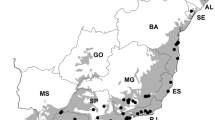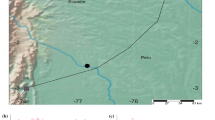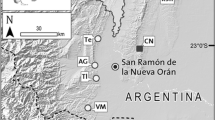Abstract
Understanding the underlying mechanisms that generate species turnover or beta diversity among biological communities is a central theme in ecology. Here, we distinguish the effects of geographic distance and climatic dissimilarity on species turnover of vascular plants in alpine meadow communities on the Tibetan Plateau in China. We calculated species turnover between each pair of 17 sites, using the Jaccard’s and Simpson’s indices. We selected six variables to quantify climate at each site, and subjected values of the climatic variables to a principal component analysis. We applied a variance partitioning approach to disentangle the effects of geographic distance and climatic dissimilarity on species turnover in alpine meadow communities. We also examined the effect of elevation variation on species turnover. Geographic distance and climate dissimilarity together explained 49.1 % of the variation in compositional difference between alpine meadow communities; the amount of the variation explained purely by geographic distance and purely by climatic dissimilarity was 6.8 % and 2.8 %, respectively. When geographic distance, climate dissimilarity, and elevation difference were included in an analysis, they together explained 55 % of the variation in compositional difference between alpine meadow communities; the pure effect of each of the three sets of explanatory variables was 4.8, 4.3, and 3.5 %, respectively. The fact that the vast majority of the variation explained by geographic distance and climatic dissimilarity cannot be independently attributed to either factor suggests that the two factors operate together in determining regional patterns of species composition in alpine meadows on the Tibetan Plateau.



Similar content being viewed by others
References
Anderson MJ, Crist TO, Chase JM, Vellend M, Inouye BD, Freestone AL, Sanders NJ, Cornell HV, Comita LS, Davies KF, Harrison SP, Kraft NJB, Stegen JC, Swenson NG (2011) Navigating the multiple meanings of ß diversity: a roadmap for the practicing ecologist. Ecol Lett 14:19–28
Axelrod DI, Al-Shehbaz I, Raven PH (1998) History of the modern flora of China. In: Zhang A, Wu S (eds) Floristic characteristics and diversity of East Asian plants. China Higher Education Press, Beijing, pp 43–55
Baselga A (2007) Disentangling distance decay of similarity from richness gradients: response to Soininen et al. 2007. Ecography 30:838–841
Cottenie K (2005) Integrating environmental and spatial processes in ecological community dynamics. Ecol Lett 8:1175–1182
Duivenvoorden JF, Svenning J-C, Wright SJ (2002) Beta diversity in tropical forests. Science 295:636–637
Editorial Committee of Vegetation Map of China (2007) Vegetation Map of the People’s Republic of China (1:1000,000). Geological Publishing House, Beijing
Fang X-M, Li J-J (1998) Uplift stages and environmental changes of the Plateau since 3.4 Ma. In: Shi YF, Li JJ, Li BY (eds) Uplift and environmental changes of Qinghai-Tibetan Plateau in the late Cenozoic. Guangdong Science and Technology Press, Guangzhou, pp 394–408
Girdler EB, Barrie BTC (2008) The scale-dependent importance of habitat factors and dispersal limitation in structuring Great Lakes shoreline plant communities. Plant Ecol 198:211–223
Heino J, Bini LM, Karjalainen SM, Mykra H, Soininen J, Vieira LCG, Diniz-Filho JAF (2010) Geographical patterns of micro-organismal community structure: are diatoms ubiquitously distributed across boreal streams? Oikos 119:129–137
Hijmans RJ, Cameron SE, Parra JL, Jones PG, Jarvis A (2005) Very high resolution interpolated climate surfaces for global land areas. Int J Climatol 25:1965–1978
Huang R (1987) Vegetation in the northeastern part of the Qinghai-Xizang Plateau. In: Hovermann J, Wang W (eds) Reports of the northeastern part of the Qinghai-Xizang (Tibet) Plateau. Science Press, Beijing, pp 438–489
Hubbell SP (2001) The unified neutral theory of biodiversity and biogeography. Princeton University Press, Princeton
Jaccard P (1912) The distribution of the flora in the alpine zone. New Phytol 11:37–50
Jones MM, Tuomisto H, Clark DB, Olivas P (2006) Effects of mesoscale environmental heterogeneity and dispersal limitation on floristic variation in rain forest ferns. J Ecol 94:181–195
Karst J, Gilbert B, Lechowicz MJ (2005) Fern community assembly: the roles of chance and the environment at local and intermediate scales. Ecology 86:2473–2486
Legendre P (2008) Studying beta diversity: ecological variation partioning by multiple regression and canonical analysis. J Plant Ecol 1:3–8
Legendre P, Legendre L (1998) Numerical ecology, 2nd edn. Elsevier, Amsterdam
Legendre P, Lapointe F-J, Casgrain P (1994) Modeling brain evolution from behavior: a permutational regression approach. Evolution 48:1487–1499
McCune B, Mefford MJ (1999) PC-ORD: multivariate analysis of ecological data (version 4.0). MjM Software Design, Gleneden Beach
Nekola JC, White PS (1999) The distance decay of similarity in biogeography and ecology. J Biogeogr 26:867–878
Noble SR, Searle MP (1995) Age of crustal melting and leucogranite formation from U-Pb zircon and monazite dating in the western Himalayas, Zanskar, India. Geology 23:1135–1138
Nogueira IS, Nabout JC, Ibañez MSR, Bourgoin LM (2010) Determinants of beta diversity: the relative importance of environmental and spatial processes in structuring phytoplankton communities in an Amazonian floodplain. Acta Limnol Bras 22:247–256
Potts MD, Ashton PS, Kaufman LS, Plotkin JB (2002) Habitat patterns in tropical rain forests: a comparison of 105 plots in Northwest Borneo. Ecology 83:2782–2797
Qian H (2002) A comparison of the taxonomic richness of temperate plants in East Asia and North America. Am J Bot 89:1818–1825
Qian H (2009) Beta diversity in relation to dispersal ability for vascular plants in North America. Glob Ecol Biogeogr 18:327–332
Qian H, Ricklefs RE (2007) A latitudinal gradient in large-scale beta diversity for vascular plants in North America. Ecol Lett 10:737–744
Qian H, Klinka K, Kayahara GJ (1998) Longitudinal patterns of plant diversity in the North American boreal forest. Plant Ecol 138:161–178
R Development Core Team (2009) R: a language and environment for statistical computing. R Foundation for Statistical Computing, Vienna. http://www.R-project.org/
Ruokolainen K, Tuomisto H (2002) Beta-diversity in tropical forests. Science 297:1439
Searle M (1995) The rise and fall of Tibet. Nature 374:17–18
Şengör AMG, Natal’in BA (1996) Paleotectonics of Asia: fragments of a synthesis. In: Yin A, Harrison TM (eds) The tectonic evolution of Asia. Cambridge University Press, Cambridge, pp 486–640
Sharma KW (1984) The sequence of phased uplift of the Himalayas. In: Whyte RO (ed) The evolution of East Asian environment, vol 1. Center of Asian Studies, Hong Kong, pp 56–70
Shi GR (1993) A comparative study of 39 binary similarity coefficients. Mem Assoc Australas Palaeontol 15:329–341
Shi YF, Li JJ, Li BY (1998) Uplift and environmental changes of Qinghai-Tibetan Plateau in the late Cenozoic. Guangdong Science and Technology Press, Guangzhou
Shimono A, Zhou H, Shen H, Hirota M, Ohtsuka T, Tang Y (2010) Patterns of plant diversity at high altitudes on the Qinghai-Tibetan Plateau. J Plant Ecol 3:1–7
Simpson GG (1960) Notes on the measurement of faunal resemblance. Am J Sci 258-A:300–311
Tuomisto H, Ruokolainen K, Yli-Halla M (2003) Dispersal, environment, and floristic variation of western Amazonian forests. Science 299:241–244
Vormisto J, Svenning JC, Hall P, Balslev H (2004) Diversity and dominance in palm (Arecaceae) communities in terra firme forests in the western amazon basin. J Ecol 92:577–588
Wilkinson L, Hill M, Welna JP, Birkenbeuel GK (1992) SYSTAT for Windows: statistics. SYSTAT Inc., Evanston
Zhang YQ, Tang YH, Jiang J, Yang YH (2007) Characterizing the dynamics of soil organic carbon in grasslands on the Qinghai-Tibetan Plateau. Sci China Ser D Earth Sci 50:113–120
Zhao D, Li S, Wu S (2006) Progress on climate–vegetation modeling in the Tibetan Plateau. Prog Geogr 25:68–78
Acknowledgments
We are grateful to two anonymous reviewers for helpful comments, Yanhong Tang and Huakun Zhou for their assistance with field data collection, and Xianli Wang for compiling climate data. The vegetation survey was supported by the Global Environment Research Coordination System, Ministry of the Environment, Government of Japan, for the project “Early detection and prediction of climate warming based on long-term monitoring on the Tibetan Plateau”, and by KAKENHI (Grant-in-Aid for Young Scientists (B) 19770020). Institute of Applied Ecology, Chinese Academy of Sciences, provided with support to the project.
Author information
Authors and Affiliations
Corresponding author
Electronic supplementary material
Below is the link to the electronic supplementary material.
Rights and permissions
About this article
Cite this article
Qian, H., Shimono, A. Effects of geographic distance and climatic dissimilarity on species turnover in alpine meadow communities across a broad spatial extent on the Tibetan Plateau. Plant Ecol 213, 1357–1364 (2012). https://doi.org/10.1007/s11258-012-0095-4
Received:
Accepted:
Published:
Issue Date:
DOI: https://doi.org/10.1007/s11258-012-0095-4




